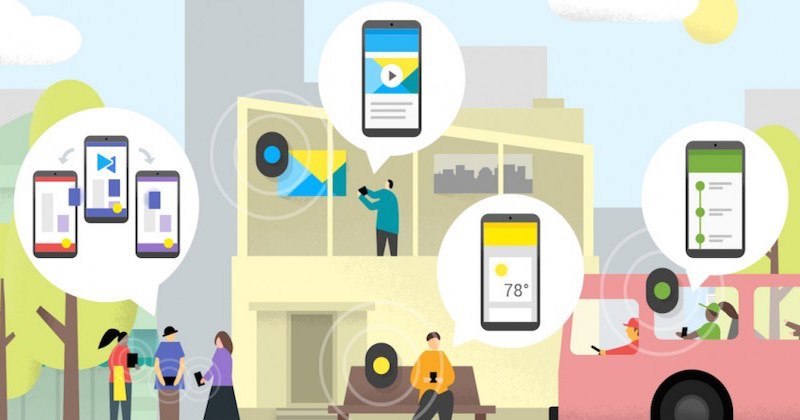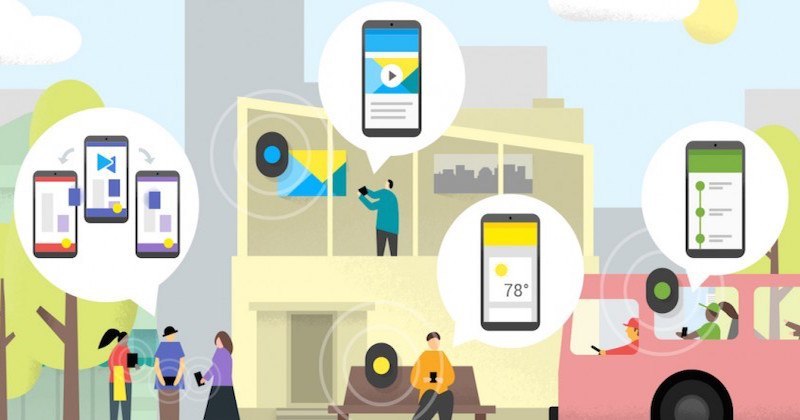
What Eddystone, Google’s Take On Beacons, Means For Digital Signage And Digital OOH
July 16, 2015 by Dave Haynes

I am traveling, so little to no time to read or write – or dig into new tech that has just emerged. So when people started emailing me saying, “Hey, did you see the Eddystone thing?” all I could respond was “Yeah, kinda sorta.”
Fortunately, Bryan Mongeau, the Vice President of Technology at BroadSign has evidently been around his Montreal shop this week, and digested the news about Google’s take on beacons. He offered to do a Q&A about what it means …
Q: So what exactly is Eddystone anyway?
Eddystone is Google’s recently announced alternative to Apple’s iBeacon. Going a bit deeper into the tech, Eddystone is an open-source, unidirectional, proximity-based BLE protocol that in many ways addresses the shortcomings of iBeacon. It can support multiple different payloads and has a range of approximately 50 meters.
Q: What are the differences between iBeacon and Eddystone?
Firstly, if you decide to use iBeacons, you are limiting yourself to the Apple ecosystem of iOS devices. According to recent market share stats, that means excluding the 70-80% of devices running Android. There is no official Android support for iBeacon and unofficial attempts to support it on Android have met resistance from Apple.
In contrast, with Eddystone the entire smart device ecosystem is supported: it has native OS level support (via Nearby API) from Android 2.3 and above, as well as an official iOS SDK.
Second, and possibly most important, iBeacons require an app to be installed on the user’s device to detect a beacon. With Eddystone-url (one of the three Eddystone variants), no app is required. By all online accounts, on Android the beacon simply appears in the user’s notification panel and a single tap takes you to the URL.
What is less clear at this time is the iOS behaviour. Seeing as it requires an SDK, it seems logical to me that an app will still be required on iOS.
Lastly, Eddystone is more flexible than iBeacon. There are three variants of the protocol (URL, UID and TLM) as opposed to the one variant (UID) of iBeacon. Also, the protocol is versioned, allowing more functionality to be built on top of the protocol and this will ultimately enable more use cases.
Q: When can Eddystone be deployed?
Google has timed the announcement with a few hardware OEM’s that have Eddystone beacons immediately available. In many cases, seeing as the underlying RF tech is the same (BLE), existing iBeacons can speak Eddystone with a firmware upgrade.
Q: That’s nice, but why does this tech matter for Digital OOH?
It matters big time because all the current methods for interfacing a mobile device with a digital public display have too much friction.
Mobile interaction rates as a percentage of overall audience are too low, because no one wants to install another app (for iBeacons). QR codes are clunky for much the same reason (requires a reader app). NFC needs close physical proximity, which impedes many types of installations, and user knowledge about NFC and how to enable it is low. SMS brings the fear of being spammed on your mobile phone number. WiFi landing pages require going into your device settings to connect.
Eddystone-url holds the promise of lowering the barriers for interacting with public displays. Once deployed, the tech could lift interaction rates for products like Blue Bite, Pattison’s Engage, iZipline and BroadSign Mobile.



Leave a comment